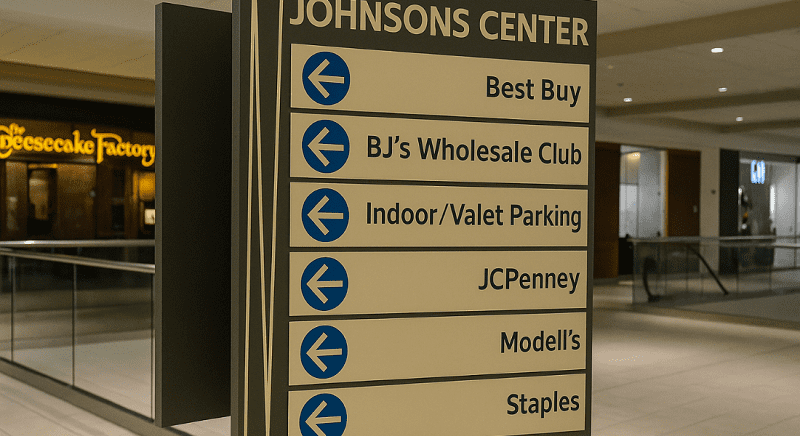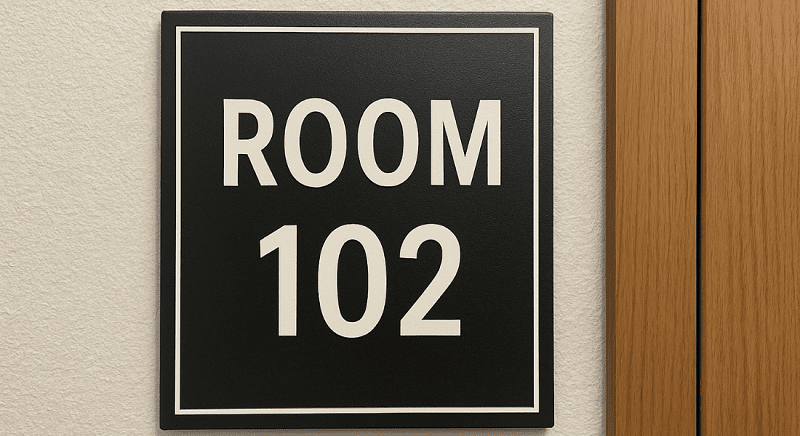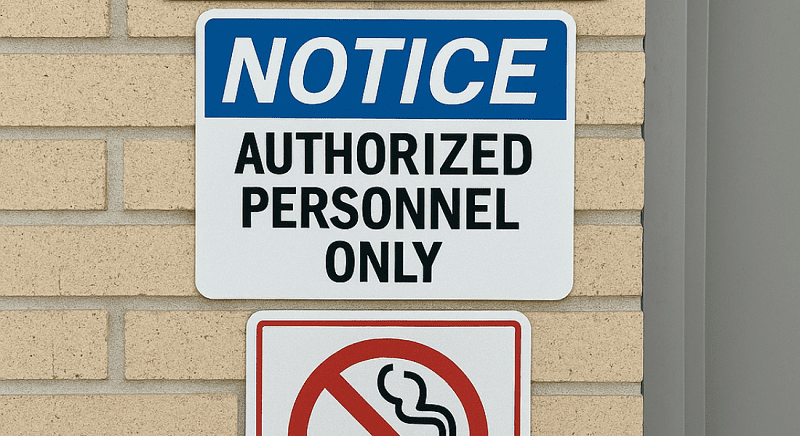Wayfinding signage isn’t just about aesthetics—it’s about guiding your visitors safely and efficiently while improving their overall experience.
At MetroCenter Signworks, a trusted Nashville sign company, we help businesses design and install clear wayfinding signs that make it easy for anyone to navigate your space. In this guide, we’ll break down the four main types of wayfinding signs, provide real-world examples, and explain how each can benefit your business.
Table of Contents
ToggleThe 4 Types of Wayfinding Signage
Before we dive into the details, here’s the big picture. The four types of wayfinding signage are:
- Directional signage
- Identification signage
- Informational signage
- Regulatory signage
Let’s go over each one and how it fits into a business.

Directional Signage
Directional signageguides visitors from one point to another. Think arrows, hallway signs, or overhead boards showing “Lobby,” “Restrooms,” or “Exit.”
Placement: Corridors, intersections, open areas.
Example:
In a hospital, directional signs like “Radiology — 3rd Floor, Elevator B” help patients find their way quickly, reducing stress and congestion.
Why it matters:
Directional signs can reduce visitor confusion by up to 50% and help businesses manage traffic flow efficiently.
Tip: Use clear arrows, consistent colors, and high-contrast fonts for maximum visibility.

Identification Signage
Identification signage tells people where they are. These signs confirm rooms, departments, or landmarks.
Placement: Doorways, entrances, key areas.
Example:
A law office may use “Room A – Client Consultations” to guide clients to the correct conference room. Retail stores use aisle signs like “Produce” or “Dairy.”
Impact: Visitors immediately know they’ve reached the right spot, improving efficiency and reducing frustration.

Informational Signage
Informational signage provides helpful details visitors need, like hours, accessibility info, building maps, or Wi-Fi zones.
Placement: Lobbies, entrances, shared spaces.
Example:
A college campus student union might display a map with restrooms, elevators, and emergency exits.
Benefit: Informational signs enhance intuitive navigation, improving the overall visitor experience.
Pro Tip: Make them universally understandable using clear symbols and concise language.

Regulatory Signage
Regulatory signage enforces rules, ensures safety, and helps with legal compliance.
Placement: Entrances, restricted areas, public or high-traffic spaces.
Example:
Warehouses use signs like “Authorized Personnel Only – Safety Gear Required.” Parking lots display “No Parking” or “Fire Lane – Do Not Block.”
Why it’s critical: Regulatory signs protect your business and visitors while maintaining order.
What Makes Effective Wayfinding Signage?
Great signage is more than text on a board—it’s part of your business’s user experience. Key factors include:
- Simplicity: Avoid jargon and keep messages clear.
- Consistency: Maintain uniform fonts, colors, and style.
- Accessibility: Use ADA-compliant fonts, contrast, and Braille when needed.
- Placement: Signs should be at eye level and well-lit where people make decisions.
Stat: Businesses with clear signage report 80% higher visitor satisfaction and fewer staff interruptions for directions.
How Do You Choose the Right Type of Signage for Your Business?
Start by asking: What do people need to know when they walk into your space?
- Do they need to find their way to specific rooms? Use directional signage.
- Are they confused about where they are? Use identification signs.
- Do they have questions about policies or maps? Use informational signs.
- Are there safety rules or restrictions? Use regulatory signs.
Every business is different, but most benefit from using all 4 types in a smart & coordinated place.
Choosing the Right Wayfinding Signs for Your Business
AtMetroCenter Signworks, we’re a trusted sign company based in Nashville, TN.
Ask yourself:
- Do visitors need to find rooms or offices quickly? → Directional signs
- Are people unsure of their current location? → Identification signs
- Do visitors need additional info like maps or rules? → Informational signs
- Are safety or compliance rules necessary? → Regulatory signs
Most businesses benefit from a coordinated combination of all four types.
Why Work With MetroCenter Signworks in Nashville, TN
We design, plan, and install wayfinding signs that match your brand, space, and visitor needs. Our team ensures your signage is:
- Clear & easy to read
- Strategically placed
- ADA-compliant and safe
- On-brand and professional
📞 Call us today for a free consultation and quote!
Key Takeaways
- Wayfinding signage improves navigation, safety, and visitor confidence.
- The four main types: Directional, Identification, Informational, Regulatory.
- Use both permanent and temporary signage strategically.
- Work with an expert to ensure signs fit your space, brand, and visitors’ expectations.
FAQs
Q. What are the four types of wayfinding signs?
A. Identification, Directional, Informational, and Regulatory. Each serves a different purpose to help visitors navigate spaces effectively.
Q. What are Wayfinder signs?
A. Any signs that help visitors navigate a building, campus, or property, including arrows, maps, and entrance labels.
Q. What makes good wayfinding signage?
A. Clear, consistent, readable, high-contrast, and strategically placed where people make navigation decisions.
Q. How do wayfinding signs improve business efficiency?
A. They reduce visitor confusion, improve safety, and allow staff to focus on core tasks instead of giving directions.
